What is the Difference Between Closed and Open Circuits?
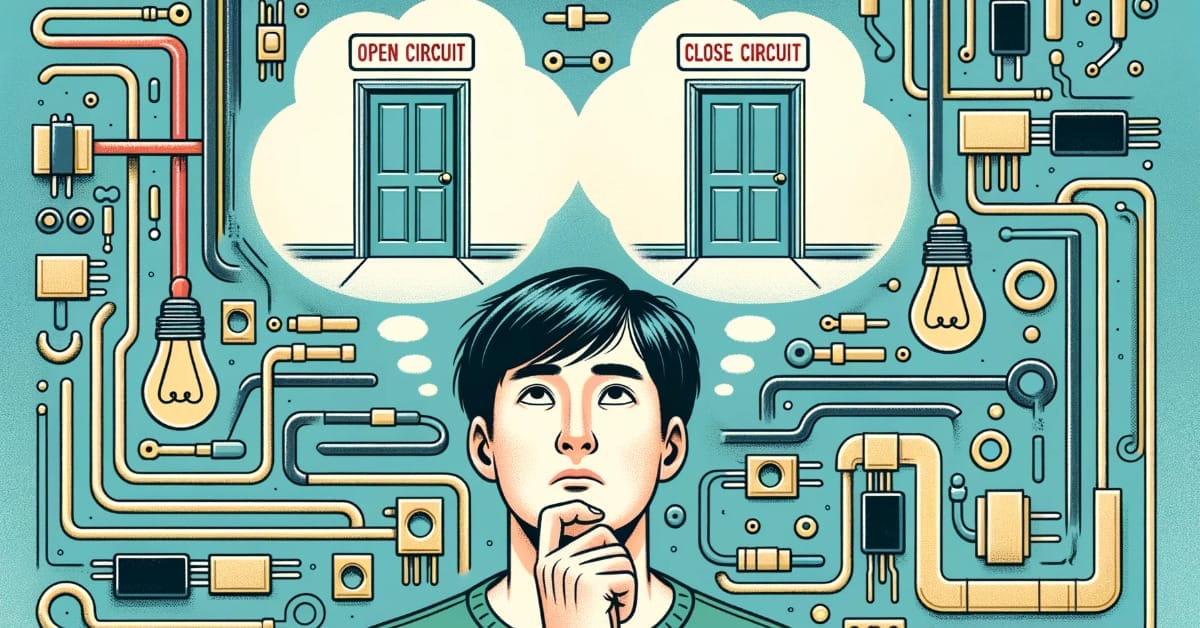
Electricity flows along a circuit, and circuits can be controlled by opening and closing as required.
But sometimes, the current flow might get interrupted, or a short circuit might be created. Also, there are ways we can intentionally control a circuit to make it open or closed. To understand all this, we need to know the difference between an open and closed circuit.
The difference between an open and closed circuit is that a circuit is open when there is a break somewhere along its path, which prevents an electric charge from flowing. It only flows when there is no such break, i.e., when the circuit is completely closed. We can open or close a circuit using a switch or a protector, such as a fuse or a circuit breaker.
I will explain this difference in detail with examples and illustrations before also pointing out more differences for detailed insight.
What is an Open and Closed Circuit?
An Open Circuit
In an open circuit, electrical current is prevented from flowing through it.
Unlike a closed circuit, this type of circuit has an incomplete path that is interrupted or broken. The discontinuity makes the current unable to flow.
A Closed Circuit
In a closed circuit, electrical current is allowed to flow through it.
Unlike an open circuit, this type of circuit has a complete path without interruption or break. The continuity makes it possible for the current to flow.
Illustrations
In diagrams of electrical circuits, we usually indicate an open and closed part of the circuit by curved brackets and a thick dot, as shown in the picture below.
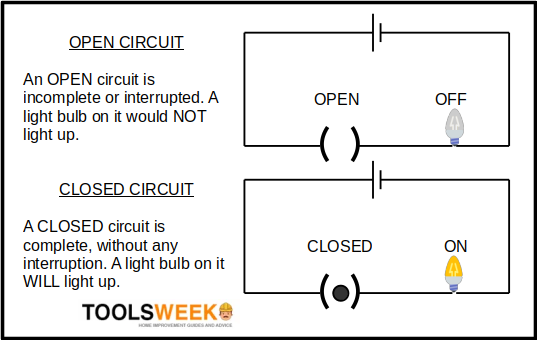
How a Closed Circuit Opens, and Vice Versa
A closed circuit can become open, or vice versa, for an open circuit to become closed.
How a Closed Circuit Can Become Open
If the current flowing through a closed circuit is interrupted, it becomes an open circuit.
A closed circuit can become open accidentally if, for instance, there is a break somewhere along the circuit due to a broken wire. But opening a closed circuit can also be managed intentionally or by design using switches, fuses, and circuit breakers.
So an initially closed circuit can be opened by a broken wire by turning the switch off if the fuse breaks or the circuit breaker trips.
How an Open Circuit Becomes Closed
If current starts flowing through an open circuit, it must be closed.
An open circuit can become closed accidentally if, for instance, a join is made somewhere along the circuit due to wrong wiring or a short circuit. But closing an open circuit can also be managed intentionally or by design using switches, fuses, and circuit breakers.
So an initially open circuit can become closed by wrong wiring, a short circuit, by turning the switch on, if a new fuse is inserted, or if the circuit breaker is switched on.
What Happens When a Circuit is Opened or Closed
I will show you what happens in the case of a lighting circuit with one or two switches.
A Circuit With One Switch
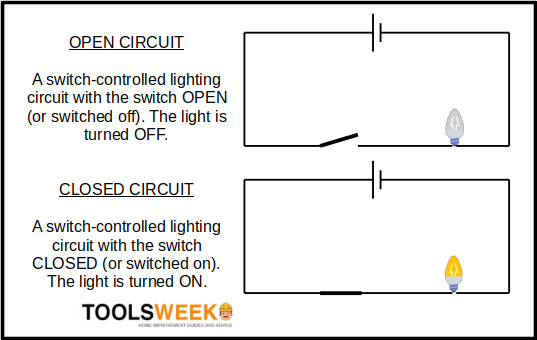
A simple circuit with only one switch can only be connected in series with a load, such as a light bulb.
In this case, the operation of the light bulb depends entirely on that one switch. If it is closed (turned on), the light will be on, and if it is open (turned off), the light will also be off.
This circuit arrangement is common in high-power circuits when we must be sure an appliance, such as a water pump motor, is controllable by a single switch.
A Circuit With Two Switches
A circuit with two switches also has practical applications.
What happens when a circuit is opened or closed depends on whether the circuit is complete or incomplete and whether it is a series or parallel circuit.
Consider a circuit with two switches, as may be found at the top and bottom of a staircase, to control a single light bulb. The table below considers all four possibilities for each circuit type.
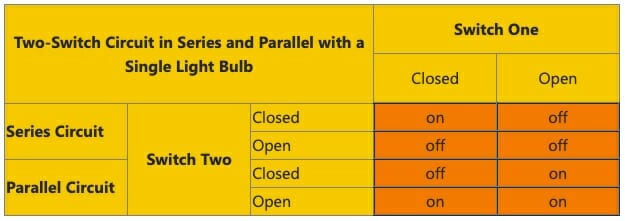
As you can see in the above table, BOTH switches must be on (or closed) in a series circuit for the light to be on. If either is off or both are off, the light will be off, as it would open the circuit.
In a parallel circuit, only ONE of the switches must be on (or closed) for the light to be on. The light will only be off if both switches are turned off, which would open the circuit completely.
For a staircase, you need to be able to turn the light off from either the top or bottom switch, so you can see that a parallel arrangement is the most suitable one.
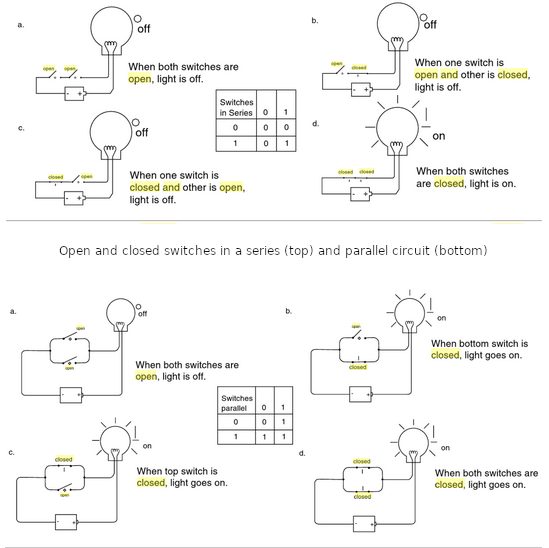
Electrical Theory
We can consider different aspects to understand the difference between a closed and open circuit in more detail. These differences are summarized in the table below.
An open circuit is in an off state because the circuit is broken or incomplete, whereas a closed one is in an off state because the circuit is continuous or complete. An open circuit does not allow current to flow, and there is neither electron transfer nor the transfer of electrical energy. In contrast, an open circuit allows current to flow. Consequently, electrons transfer and electrical energy are also transferred.
The voltage (or potential difference) across the break in an open circuit will be equal to the supply voltage and is considered non-zero, but it would be almost zero in a closed circuit.
We can also show another difference in resistance using Ohm’s Law (V = IR). An open circuit will be infinite due to the zero current (I = 0), but in a closed circuit, it will depend on the extent of the current (R = V / I).
| Aspect | Open Circuit | Closed Circuit |
| State | Open or OFF | Closed or OFF |
| Circuit path | Broken, interrupted, or incomplete | Continuous or complete |
| Current | No current flow | Current flows |
| Nature | No electron transfer | Electron transfer |
| Energy | No electrical energy transferred | Electrical energy is transferred |
| Voltage (PD) across the break/switch | Equal to the supply voltage (non-zero) | Almost zero |
| Resistance | Infinite | Equal to V / I |
| Symbol |  |  |
So a circuit is only complete or functional if it is closed, not if it is open.
Besides having a complete and uninterrupted route for current to flow, a closed circuit requires the following elements:
- An active voltage source, such as a battery.
- The path is made of a conductor, such as a copper wire.
- A load on the circuit, such as a light bulb.
If all these conditions are met, the electrons will be free to flow through the entire circuit.
Take a look at some of our related articles below.
- How to add a neutral wire to an existing light switch
- How to wire a light bulb holder
- How to test a circuit breaker with a multimeter
Reference
(1) Leonard Styles. Deciphering cyberspace: Making the most of digital communication technology. SAGE. 2003.
